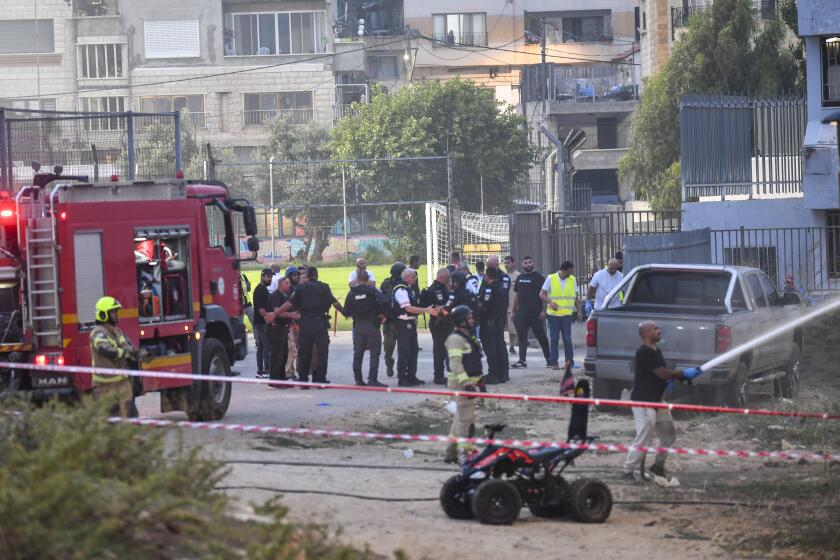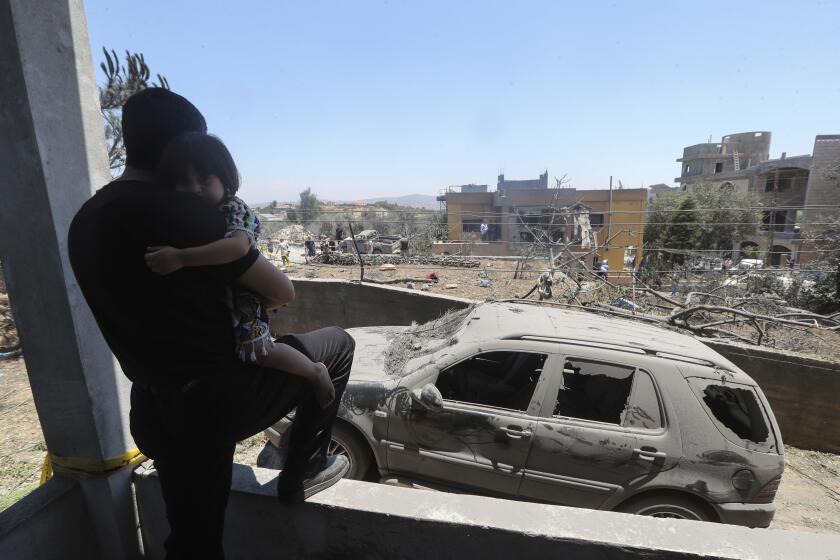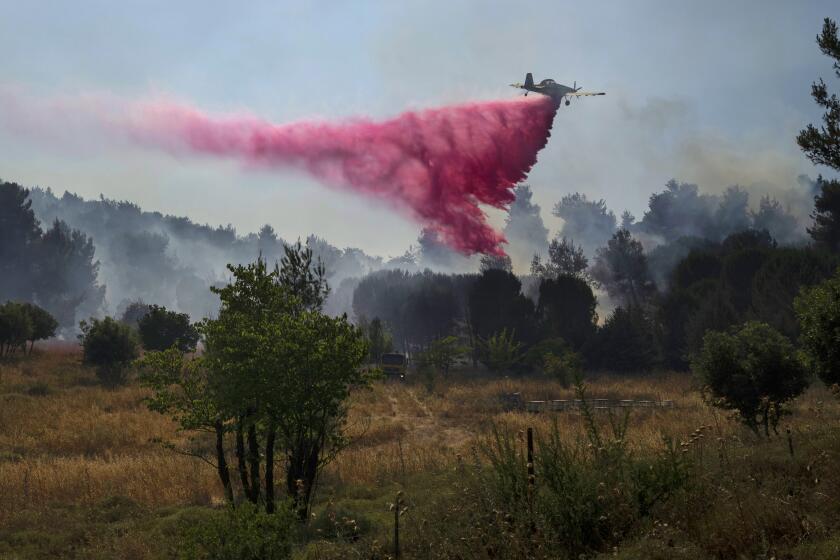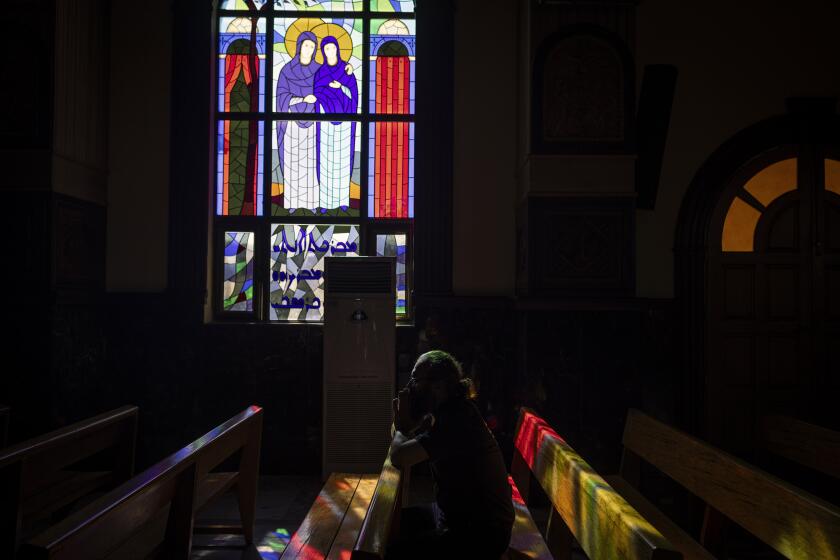A cratered field, a mangled fence. Clues emerge from strike that killed 12 children in Golan Heights

JERUSALEM — Two days after a rocket slammed into a soccer field in the Israel-controlled Golan Heights, killing 12 children, many questions remain about the attack on the Druze town of Majdal Shams.
Israel accused Hezbollah in Lebanon of deliberately targeting civilians, while the Lebanese militant group quickly issued a rare denial of any responsibility for the attack.
With Israel vowing retaliation for what was the highest civilian death toll in Israel-held territory since Hamas’ Oct. 7 attack on southern Israel, diplomats rushed to prevent an escalation that could spiral into an all-out war after months of exchanges between Israel and Hezbollah over the Lebanese-Israeli border.
Weapons experts told the Associated Press that evidence points to a rocket from Lebanon hitting the field. But they raised the possibility that the hit on civilians was an accident.
Israel says at least 11 people have been killed by a rocket strike in the Israeli-controlled Golan Heights. It blames Lebanon’s Hezbollah, which issues denial.
Here’s what we know and what remains unclear about the attack.
The strike
The strike left a crater about 2 yards wide, breaking through the carpet of artificial grass where the children were playing. Around it were scattered burned-out bicycles and scooters, some electric bikes with their batteries melted. Walls of a nearby tent and shelter were pockmarked from shrapnel.
The Israeli military’s Chief of Staff Lt. Gen. Herzi Halevi said an Iranian-made Falaq rocket with a 117-pound warhead belonging to Hezbollah was used in the attack that landed in the town of more than 11,000 inhabitants.
Israel released images of rocket fragments it said the military found, with visible lettering that matched pictures of Falaq rockets also provided by the military. The AP was unable to verify that the fragments were found on-site. No ordinance debris was visible when AP reporters visited the site Monday.
The Israeli military was investigating why its renowned missile defense system called Iron Dome did not intercept the rocket.
Israel has assassinated two dozen Hezbollah commanders in Lebanon since last fall amid an intelligence war employing cellphones, drones and fake rocks.
While Iron Dome’s radar detected the launch, it did not release an interceptor missile to knock down the rocket, an Israeli military official told the AP, speaking on condition of anonymity to discuss the matter.
The military said the flight time may have been too brief. The rocket was fired from just north of the Lebanese town of Chebaa, about 6 miles from Majdal Shams, it said. Hezbollah has experimented with launching rockets from a shorter distance.
The Iron Dome alert set off sirens at 6:18 p.m. Majdal Shams’ local council reported the rocket landed less than a minute later, leaving no chance for the children to run to shelters.
“At very short distance, you don’t have enough time to operate the Iron Dome,” said Yehoshua Kalisky, a senior researcher at the Institute for National Security Studies, a Tel Aviv think tank. It’s nearly impossible to intercept rockets fired from within 3 miles that take two to three seconds to reach their destination, he said.
As a result, the interception rate along the northern border is considerably lower than in central Israel, where Iron Dome batteries have more time, he said.
The escalating war between Hezbollah and Israel — coupled with scorching heat — has sparked fires that are destroying forests and farmland.
Hezbollah’s denial
Hezbollah, the most powerful paramilitary and political force in Lebanon, was quick to say it was not behind the attack, a rare denial from a group that normally claims every attack launched.
What Hezbollah would gain from attacking a Druze community is unclear. Many Druze in the Golan see themselves as citizens of Syria, where the government in Damascus is a Hezbollah ally. A strike on them could hurt the militant group’s standing — including with Druze in Lebanon — when it’s trying to keep support in the war.
An overt intentional strike on civilians would also be a dramatic escalation in Hezbollah’s near daily exchanges with Israel. The group’s officials have said they don’t aim to expand the war and will halt their strikes when a cease-fire is reached in Gaza.
Christian areas scattered across Hezbollah-dominated southern Lebanon find themselves on the front line of a fight that few see as theirs.
In the thousands of rockets it has fired since October, Hezbollah has insisted it targets military and intelligence installations. Still, Hezbollah rockets have hit civilian areas. Before Saturday’s bloodshed, strikes had killed 13 civilians and 22 soldiers in Israel. In Lebanon, Israel’s attacks have killed more than 500 people, including 90 civilians.
Just before news of Saturday’s deadly attack, Hezbollah claimed at least two strikes, using Katyusha rockets and the larger Falaq-1, targeting an Israeli military base on Mount Hermon, about 2 miles north of Majdal Shams.
A small militant faction allied with Hezbollah that also operates from southern Lebanon, often from near Chebaa, also denied responsibility for the attack. Hezbollah-allied media questioned whether Israel was looking for an excuse to widen the war amid the most serious push yet to reach a cease-fire in Gaza.
Was it an error?
From satellite images, pictures and videos from the scene and analysis of previous launches, experts said the evidence fits with a rocket attack.
“The evidence that we can see from the ground ... is much more consistent with that of a rocket artillery of the type and size of the Falaq,” said Richard Weir, crisis and weapons researcher with Human Rights Watch.
The warhead would explode on impact with a deadly high-explosive load, spraying irregularly shaped fragments.
Dr. Ran Steinberg, chief of Pediatric Surgery at Rambam Hospital who took part in treating children wounded in the blast, told the AP that irregular, jagged pieces of shrapnel were removed from their bodies.
Weir said the damage did not appear consistent with the scenario of a hit by an air defense missile that malfunctioned. Such missiles are designed to disperse regularly shaped fragments in every direction, and there was no sign of such fragmentation.
The shape of the crater and the direction a fence was blown down indicate that the rocket came from the north, said Chris Cobb-Smith, a weapons analyst.
He said that without independent verification of the munition’s remnants it is impossible to say who is to blame.
Weir said a Hezbollah rocket aimed at the military position on Mount Hermon may have overshot its target, landing in Majdal Shams. He said any number of mistakes could have taken place, including a mechanical fault or human error in estimating the distance.
“These kinds of things happen even with the best trained forces, he said. “So it is possible that, given that this is an unguided piece of rocket, that this was a mistake.”
The Druze stance
After Israel blamed Hezbollah for the blast, many Druze leaders in Lebanon, Syria and Israel spoke out against what they called an attempt to drive a wedge within the close-knit community. Followers of the Druze faith, which began as an offshoot of Shiite Islam, are divided between the three countries.
Some 300 Majdal Shams residents protested a visit by Israeli Prime Minister Benjamin Netanyahu on Monday, shouting that he was exploiting the bloodshed for political gain.
Only 20% of residents in Majdal Shams, part of the Golan Heights annexed by Israel in 1981, have accepted Israeli citizenship. Many still consider themselves citizens of Syria.
“For sure, it was not targeting Majdal Shams. There are many Israeli military bases around the town. I expect this threat was heading their way,” said Nabeeh Abu Saleh, a paramedic from the town who rushed to the scene of the attack on Saturday.
Nothing prepared Abu Saleh, who has 25 years of experience as a paramedic, for what he saw. Some body parts were found 100 yards from the explosion. One of his nephews was killed, another wounded.
The military said Iron Dome sirens have gone off in Majdal Shams 30 times during the conflict. A few months ago, a rocket landed short of the town, Abu Saleh said.
“We buried our children. We don’t want retaliation,” he said. “We have families in Lebanon, in Syria, and we have brothers here in Israel.”
Associated Press writer Frankel reported from Jerusalem and El Deeb from Beirut.
More to Read
Sign up for Essential California
The most important California stories and recommendations in your inbox every morning.
You may occasionally receive promotional content from the Los Angeles Times.













